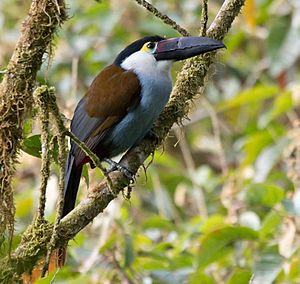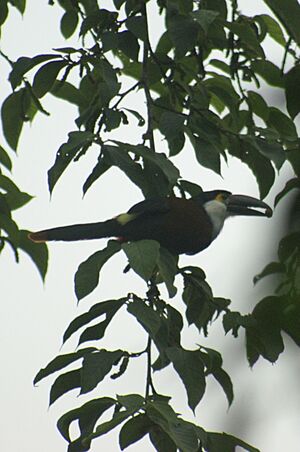Black-billed mountain toucan facts for kids
Quick facts for kids Black-billed mountain toucan |
|
|---|---|
 |
|
| Conservation status | |
| Scientific classification | |
| Genus: |
Andigena
|
| Species: |
nigrirostris
|
| Subspecies | |
|
See text |
|
 |
|
| Synonyms | |
|
|
The black-billed mountain toucan (Andigena nigrirostris) is a beautiful bird from the toucan family. It lives in the mountains of South America. You can find these colorful birds in Colombia, Ecuador, Peru, and Venezuela.
Contents
About This Toucan
The black-billed mountain toucan was first described in 1839. Scientists group animals into different types. This helps us understand them better.
There are three main types, or subspecies, of the black-billed mountain toucan:
- A. n. nigrirostris
- A. n. occidentalis
- A. n. spilorhynchus
Each subspecies is a little different, especially in where they live and the color of their bills.
What They Look Like
All three types of black-billed mountain toucans look quite similar. They have a black cap on their head and a black neck. Their upper body is a shiny bronze color. They also have a pale yellow patch on their back.
Their tail is dark gray. The tips of the middle tail feathers are a warm chestnut color. Their face and throat are white. This color changes to a pale blue on their chest. Their upper legs are chestnut, and the feathers under their tail are red.
Around their eyes, they have bare skin. This skin is pale blue in front of the eye. It turns yellow or orange behind the eye. One subspecies, A. n. occidentalis, has slightly darker chestnut thighs.
Their Bills
Both male and female toucans have the same bill pattern. However, the female's bill is usually shorter.
- The A. n. nigrirostris subspecies has a bill that is completely black.
- The A. n. spilorhynchus subspecies has a mostly black bill. It has some dark red near the bottom and on the top part of the upper bill.
- The A. n. occidentalis subspecies has a bill similar to spilorhynchus. But the red color on its upper bill extends more than halfway along the top edge.
Where They Live
The black-billed mountain toucan lives in different parts of the Andes mountains.
These toucans live in many types of places. They like cloudforests and mountain forests. They also live in more open areas. This includes farmlands near forests. They can be found in open spots with scattered trees.
They usually live at heights between 1,700 and 2,700 meters (about 5,600 to 8,900 feet). Sometimes, they are seen as low as 1,200 meters (about 3,900 feet). They have even been found as high as 3,245 meters (about 10,600 feet).
Their Daily Life
Movement
The black-billed mountain toucan stays in the same area all year. They do not migrate to different places.
Feeding Habits
These toucans mostly look for food in the tops of trees. They often forage in pairs or small family groups. Their diet includes different kinds of fruit. They also eat some insects.
Breeding
The breeding season for these toucans varies by country. In Venezuela, it is from August to November. In Colombia, it is from March to August. In Ecuador, it is thought to be around the same time or earlier. Not much else is known about how they raise their young.
Sounds They Make
The black-billed mountain toucan makes a "gwaaak" sound. It sounds a bit like a nosey honk. These sounds can be long or short, sometimes like a yelp. They also make a bill-rattling or clacking noise. This sound might be made along with their calls.
Conservation Status
The IUCN (International Union for Conservation of Nature) checks on animals. They first thought the black-billed mountain toucan was "Near Threatened." But since 2004, they have listed it as "Least Concern." This means it is not in immediate danger.
Even though it has a large range, its population size is not known. Scientists believe the number of these toucans is going down. Deforestation, which is cutting down forests, has broken up their habitat. Because of this, you might find them in certain spots, but not everywhere.






